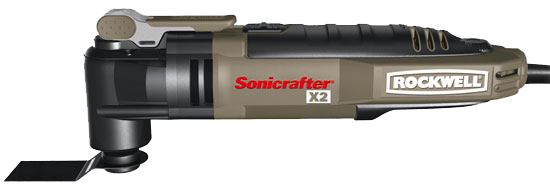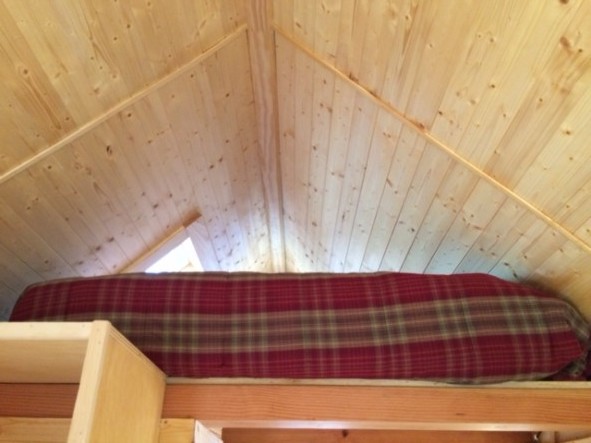It took me a while to figure this one out, because I’ve always lived in a house with standard Sheetrock walls, but a mystery came to light when I noticed something strange…more on that soon.
I have never been in a house will all wooden walls like in my tiny house. For the inside of my wall I opted for 1/4 inch Douglas fir tongue and groove siding. I’ve personally seen several tiny houses now that have used Sheetrock and it works beautifully, but I wanted the look of the fir. The fir was very easy to work with and the stuff is very light (only being 1/4 inch thick after all).

A few quick tips for working with 1/4 inch T&G interior siding:
- Most commercial packs come pre-scored on the backs so you can snap them quickly with just your hands
- Choose packs deeper in the pile and check for the grooves for damage
- Use an oscillating saw (pictured above) to cut notches around openings such as windows, doors and outlets
- Tung oil is a non toxic treatment for your interior
So now onto the mystery.
When I first hooked up my mini split, which does both my heating and cooling, I turned it on and cranked it up. Later that night I noticed as I climbed into bed and noticed that my sheets felt almost damp. I was perplexed by it and then started to worry that the dehumidifying part of the mini split wasn’t working. I checked the drain hose and a steady stream of water was coming out from it, so I knew it was working and not clogged. I decided I had just let a bunch of humid air into the house when I was going in and out and the mini split was just recovering.

Over the next week I kept finding the same thing and I began to worry that I was going to have a moisture problem. My sheets always seemed damp and I knew over time that could mean one thing: mold. I started thinking about how I could combat the problem, going over options in my mind for the better part of two weeks.
I was wondering if it was just so humid here in the South, was I in trouble? Was it that in such a small space, a human breathing put off too much moisture? These were the things swirling in my mind. Then I noticed something: my sheets were suddenly not damp any more. In fact they were perfectly dry.
This was very perplexing to me. Why was my house all of a sudden a very normal humidity, and suddenly the moisture in the air was so low?
I thought about this for a while, when all a sudden, it hit me!
It was the wooden walls! Unlike Sheetrock, Douglas fir has pores, which were used to transport water when it was a tree. Before I had installed my mini split, I left all my windows and door wide open to keep cooler, but with that came the moisture of humid NC summers and my walls drank it up.
Then I turned on the mini split and the dehumidifier started removing that moisture in the air. The wood naturally wants to equalize its open grains with the moisture in the air, so it released moisture back into the air. So essentially it took about 3 weeks for my house to breathe out all the moisture my wooden walls had taken in. My house breathes!
So the mystery is solved and my house is nice and dry. It’s interesting what you learn when you live tiny. In a larger home I’m not sure I would have noticed.

Hi Ryan,
Thank you, I am very impressed with your knowledge! Keep up the great work. I am anxious to watch your progress.
Question; What source of power do you use for cooking and hot water?
I have been told that Induction cooking uses less energy than both gas and normal electric.
Also, have you ever considered a incinerating toilet? What are your thoughts on tankless water
heaters?
Thank You, Your knowledge is a big help!!!!
John
jlcnac@yahoo.com
Hi we just installed a tankless hot water heater and I LOVE IT!! Now if conserving water is a major issue u need to consider that it takes abt a minute to minute and a half for the water to get hot…also we found that nearly all brands dont allow for great hot water temperature so we went with the rheem at home depot. We got the big one and it goes to 120 degrees. ..most are WAY less than that. The unit was $1000 plus tax and plumbing supplies. ..which cost a fortune…my mini home is 560 sq ft and I didnt have a lot of room for a tank so went this route and have zero regrets.
Was there a problem with the on-demand water heater and the amount of water pressure you had?
Thank you for this article. I am just at the point of choosing between drywall and wood inside my Tiny House. I think I will go with the interior wood siding.
I have often thought that this is the reason it is a mistake to paint the interior of wood walls in a tiny house. Paint is a pretty effective moisture barrier, so it can keep the wood from breathing.
My son went with a really nice birch plywood for his interior instead of drywall or individual tongue and groove boards. It looks good with a light coat of varethane or can be painted or stained. Not sure what thickness he used but it’s pretty minimal.
I started my Tiny Mobile from an old travel trailer that had a brand new propane w/h with 6 gal tank. Decided to keep it as the “storage tank” component of my hot water system. I put 5″ of insulation on it and use a 2.5 gal. Elec “under-counter” heater ($225)) set on high which pumps very hot water into the storage tank every time I turn on the hot faucet. Result is a hot 8.5 gallon shower in
the winter..AND a backup w/h if the electric service is interrupted. I use the hot faucet about 95% of the time anyway, which keeps the storage tank charged with hot water for about a 36 hour period. If gone for several days it takes about 2 hours of normal water usage to recharge the storage tank.
What about insulation?
Showing my ignorance here, how did you fix the humidity problem? By not using the dehumidifier?
Also, what kind of insulation did you use?
Why is a “breathing” house better than a sealed one?
If you do not mind me asking, where did you source your paneling? I have been looking for a similar product but cannot find anything less than 5/8″ T&G.
Thanks for this great article! I also haven’t been able to find any tongue and groove siding that is less than 1″ thick. Where did you find yours that is 1/4″, please?
I am designing a Tiny House and hope to finish the total build by the end of next year. I am just finishing up the details of the design before I start work on the exterior of the house and I can’t find any 1/4 inch thick stuff either. I’d love to get this into my house because of the rustic look and the weight advantages over other wood but if I can’t find it, I can’t buy it.
Where can I buy this in NC